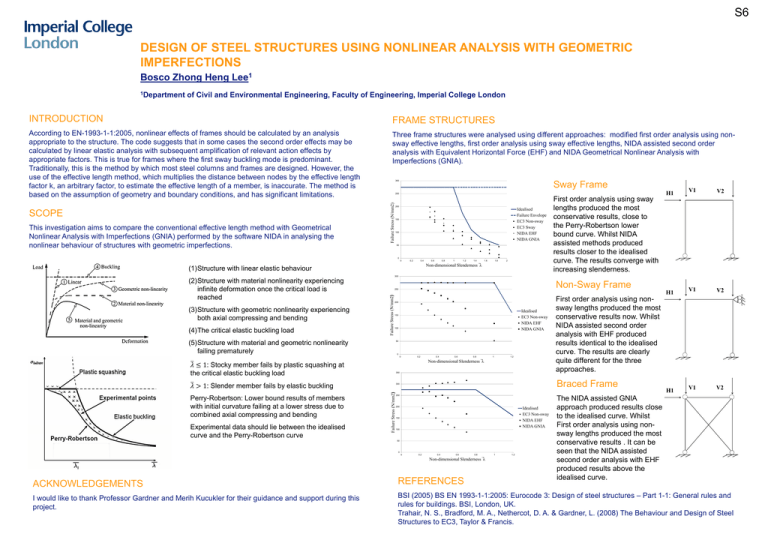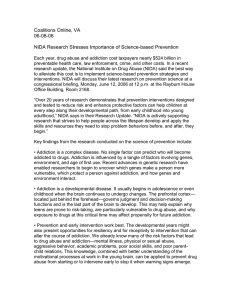DESIGN OF STEEL STRUCTURES USING NONLINEAR ANALYSIS
advertisement

S6 DESIGN OF STEEL STRUCTURES USING NONLINEAR ANALYSIS WITH GEOMETRIC IMPERFECTIONS Bosco Zhong Heng Lee1 1Department of Civil and Environmental Engineering, Faculty of Engineering, Imperial College London INTRODUCTION FRAME STRUCTURES According to EN-1993-1-1:2005, nonlinear effects of frames should be calculated by an analysis appropriate to the structure. The code suggests that in some cases the second order effects may be calculated by linear elastic analysis with subsequent amplification of relevant action effects by appropriate factors. This is true for frames where the first sway buckling mode is predominant. Traditionally, this is the method by which most steel columns and frames are designed. However, the use of the effective length method, which multiplies the distance between nodes by the effective length factor k, an arbitrary factor, to estimate the effective length of a member, is inaccurate. The method is based on the assumption of geometry and boundary conditions, and has significant limitations. Three frame structures were analysed using different approaches: modified first order analysis using nonsway effective lengths, first order analysis using sway effective lengths, NIDA assisted second order analysis with Equivalent Horizontal Force (EHF) and NIDA Geometrical Nonlinear Analysis with Imperfections (GNIA). This investigation aims to compare the conventional effective length method with Geometrical Nonlinear Analysis with Imperfections (GNIA) performed by the software NIDA in analysing the nonlinear behaviour of structures with geometric imperfections. Sway Frame 250 Failure Stress (N/mm2) SCOPE 300 200 Idealised Failure Envelope EC3 Non-sway EC3 Sway NIDA EHF NIDA GNIA 150 100 50 0 0 0.2 0.4 0.6 0.8 1 1.2 1.4 1.6 1.8 2 Non-dimensional Slenderness ̅λ (1)Structure with linear elastic behaviour First order analysis using sway lengths produced the most conservative results, close to the Perry-Robertson lower bound curve. Whilst NIDA assisted methods produced results closer to the idealised curve. The results converge with increasing slenderness. V1 V2 H1 V1 V2 H1 V1 V2 H1 300 (3)Structure with geometric nonlinearity experiencing both axial compressing and bending (4)The critical elastic buckling load Non-Sway Frame 250 Failure Stress (N/mm2) (2)Structure with material nonlinearity experiencing infinite deformation once the critical load is reached 200 Idealised EC3 Non-sway NIDA EHF NIDA GNIA 150 100 (5)Structure with material and geometric nonlinearity failing prematurely 50 0 0 0.6 0.8 1 1.2 350 𝜆 > 1: Slender member fails by elastic buckling Braced Frame 300 Failure Stress (N/mm2) Experimental data should lie between the idealised curve and the Perry-Robertson curve 0.4 Non-dimensional Slenderness ̅λ 𝜆 ≤ 1: Stocky member fails by plastic squashing at the critical elastic buckling load Perry-Robertson: Lower bound results of members with initial curvature failing at a lower stress due to combined axial compressing and bending 0.2 250 200 Idealised EC3 Non-sway NIDA EHF NIDA GNIA 150 100 50 0 0 0.2 0.4 0.6 0.8 Non-dimensional Slenderness ̅λ ACKNOWLEDGEMENTS I would like to thank Professor Gardner and Merih Kucukler for their guidance and support during this project. First order analysis using nonsway lengths produced the most conservative results now. Whilst NIDA assisted second order analysis with EHF produced results identical to the idealised curve. The results are clearly quite different for the three approaches. REFERENCES 1 1.2 The NIDA assisted GNIA approach produced results close to the idealised curve. Whilst First order analysis using nonsway lengths produced the most conservative results . It can be seen that the NIDA assisted second order analysis with EHF produced results above the idealised curve. BSI (2005) BS EN 1993-1-1:2005: Eurocode 3: Design of steel structures – Part 1-1: General rules and rules for buildings. BSI, London, UK. Trahair, N. S., Bradford, M. A., Nethercot, D. A. & Gardner, L. (2008) The Behaviour and Design of Steel Structures to EC3, Taylor & Francis.




